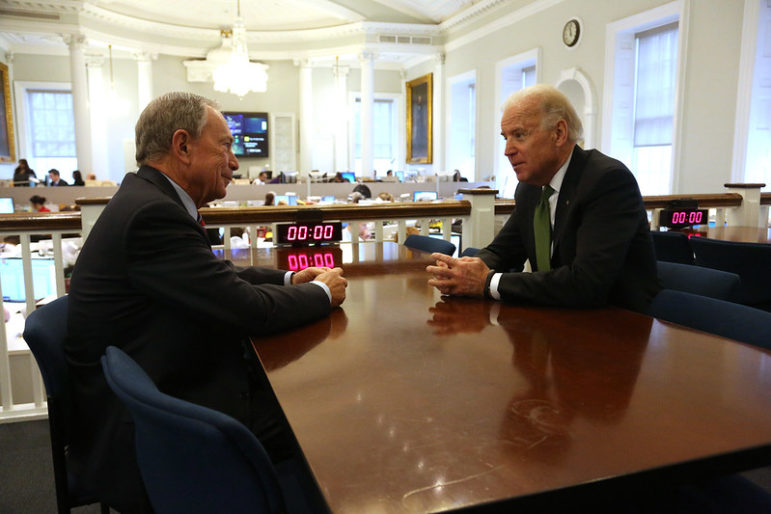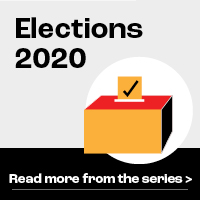Joe Biden won’t win without urban votes. If he does, what will it mean for city residents?

Ed Reed/Mayoral Photography Office
Then Vice President Biden with then-Mayor Bloomberg at City Hall in 2013.Urban voters are national Democrats’ lifeblood, allowing the party to win the popular vote in four of the last five contests despite winning a smaller and smaller number of U.S. counties.
If former Vice President Joe Biden wins the presidency, it will be because cities and suburbs went for him strongly enough to counter a rural vote that President Trump probably will command.
In a race driven by insult and ideology—where policy will take a seat in the way-back—the Democratic platform gives the only detailed indication of what a Biden victory will mean for large cities like New York.
‘Urban’ votes versus city needs
Looking at an electoral map of which party won each state in 2016 gives you one picture of how the nation is divided. Toggling to a county map, however, lends a much more precise sense of where the votes are coming from: Dark nodules of blue show up where the red states’ major cities are, and large blots of red cover the rural areas of many blue states.
If viewed through the cultural lens that holds agrarian life as somehow essentially “American,” this statistical reality might validate the Republican talking point that Democrats are increasingly the party of cultural elites. Fact is, however, U.S. residents increasingly live in urban places. Regardless of how big the red blotches are, land doesn’t vote. And those urban places, especially when defined at the county level, encompass a vast array of groups, from affluent suburban professionals to outer-urban, low-income families to unmarried millennials in center cities.
Therein lies the complicated part about how the Democrats’ urban orientation will translate into policy. Constituencies all over the metropolitan counties might agree on voting for Biden, but their policy needs differ.
The GOP stays consistent
Party platforms are not binding, and they rarely get much attention these days, but they do indicate what the respective policy apparatuses are thinking. In particular, the shifts from cycle to cycle in policy, language and emphasis reveal how that thinking has evolved.
There is little mystery as to the implications for U.S. cities of a Trump win. The president’s call last week to defund New York City as it wrestles with a fiscal and health crisis said much. The 2020 Republican platform, which is a re-adoption of their 2016 document, says even more—by saying very little.
Mention of cities in the GOP policy program is sparse. “Sanctuary cities” get a nod, as does the “murder rate soaring in our great cities.” In arguing that it’s wrong to spend Highway Trust Fund money on mass transit, the GOP platform notes that public transportation is “concentrated in six big cities.”
“Urban” areas are mentioned in the context of the depletion of rural medical staff (they’re all going to cities) and in highlighting the rural opioid problem (it’s even worst than cities). The only explicit mention of urban policy is to slam President Obama’s alleged pursuit of “an exclusively urban vision of dense housing and government transit.”
Democrats evolve
A recurring critique of the Democratic party is that it takes urban votes for granted. After all, where are those voters going to go?
Of course, those voters don’t need to go anywhere to cause problems for Democratic candidates; all they have to do is stay home to swing states red. Perhaps in recognition of this fact, the Democratic platforms in recent cycles have generally provided more detail on an urban program—whether or not that agenda was a focus of the candidates on the stump.
In 2004, the Democratic platform called for “strengthening our cities.” It did not mention public housing and offered only a glancing mention of homelessness. It read:
We will invest in the businesses, schools, and hospitals that metropolitan areas need to thrive. We will support quality housing opportunities and a balanced housing policy for all Americans, defending good rental housing and extending the American Dream of homeownership to more families. At a time when so many families are losing their homes and life savings to unscrupulous lenders, we will rein in predatory lending and expand access to mainstream financial services for urban families.
Four years later, the Democratic platform said more. “We believe that strong cities are the building blocks of strong regions, and strong regions are essential for a strong America. To build vibrant and diverse cities and regions, we support equitable development strategies that create opportunities for those traditionally left behind by economic development efforts,” the 2008 document read. “For the past eight years, the current Administration has ignored urban areas. We look forward to greater partnership with urban America.”
It called for creating a new White House Office on Urban Policy (which Obama did) and fully funding the Community Development Block Grant, as well as a long list of urban policy tools: community economic development corporations, public-private business incubators, investing in public transportation and funding for police among them. And it offered more meat on housing:
We will support affordable rental housing, which is now more critical than ever. We will implement the newly created Affordable Housing Trust Fund to ensure that it can start to support the development and preservation of affordable housing in mixed-income neighborhoods throughout the country, restore cuts to public housing operating subsidies, and fully fund the Community Development Block Grant program. We will work with local jurisdictions on the problem of vacant and abandoned housing in our communities. We will work to end housing discrimination and to ensure equal housing opportunity. We will combat homelessness …
When Obama ran for reelection in 2012, the party platform dropped mention of public housing but vowed to combat homelessness. The discussion of urban policy focused on the administration’s accomplishments, like creating the Neighborhood Revitalization Initiative and Sustainable Communities Initiative, and the support for infrastructure work that was part of the Obama stimulus plan. The 2012 platform, however, never mentioned the word “rental.” It seems like a status quo document, possibly reflecting that president’s difficulty in getting any cooperation from Congress.
In 2016, the housing agenda expanded and alluded to some especially urban concerns. “We will also expand programs to prevent displacement of existing residents, especially in communities of color; create affordable and workforce housing; … reinvigorate housing production programs, repair public housing, and increase funding for the housing choice voucher program and other rental assistance programs. And we will fight for robust funding to end homelessness in our cities and counties once and for all.”
It also pledged to “preserve and increase the supply of affordable rental housing by expanding incentives to ease local barriers to building new affordable rental housing developments” and “substantially increase funding for the National Housing Trust Fund to construct, preserve, and rehabilitate millions of affordable housing rental units.”
Of course, many of the issues the platforms discuss affect urban areas profoundly even if they are not exclusively urban issues. Gun policy is high on this list, and health programs are also key.
And this year …
The 2020 Democratic platform has a little more to say about cities, and some of the statements reflect a more nuanced analysis of the policy background, especially the role of racism in shaping it. For instance, it commits to investing in public transportation but also “repair[ing] the toxic legacy of historic investments in transportation that were designed to enforce racial segregation.”
On housing, the Democrats commit to a government-led increase in the housing supply, efforts to reduce racial disparities in homeownership, spending big on the Housing Trust Fund, expanding the Low-Income Housing Tax Credit, fully funding Section 8, and investing anew in public housing. The party says it’s “committed to ending homelessness in America,” and gets so wonky as to denounce gentrification and source-of-income discrimination. It also defends the Affirmatively Furthering Fair Housing rule, which is the kind of policy President Trump was referring to in his comments about Westchester County last week.
Word counts aren’t everything, but while the 2016 Democratic platform mentioned the word “urban” three times, this year’s policy document uses it 14 times, including in sections about the need for coastal resiliency, the dangers of heat stress and the inequalities in access to healthcare, education and digital technology.










